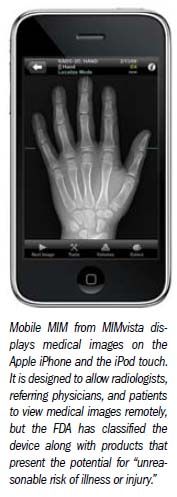Mobile image display pioneer blazes regulatory path at FDA
Mobile devices such as the iPhone and newly released iPad are attracting a lot of attention for how they might display medical images.
Mobile devices such as the iPhone and newly released iPad are attracting a lot of attention for how they might display medical images. While they hold the potential to improve communications among radiologists and referring physicians, this potential might be stymied by federal regulators.
At least four companies have made products for this purpose. None has yet made it through the FDA's clearance process. The only one that tried has become ensnared in red tape, a fate that could eventually befall the others and effectively block the widespread use of mobile devices in medical imaging. Some fear the troubles could spread even to laptops and notebooks used to display medical images.
It began two years ago, when software developer MIMvista released an app called Mobile MIM on Apple's iTunes App Store. For awhile, Mobile MIM put medical images in the hands of iPhone users around the world. Concerned, however, that it was a medical device requiring FDA review, MIMvista sought FDA clearance to market the product. Soon after, federal regulators told the company to pull its software from the iTunes App Store, warning that it was marketing a medical device without FDA clearance.
Other vendors have steered clear of this regulatory quagmire by not submitting their devices to the FDA for review. CoActiv Medical Business Solutions unveiled versions of its EXAM-PACS software for the iPhone at RSNA 2009 and for the iPad early this year. In March, Merge Healthcare released its eFilm Mobile on the iTunes App Store and iCRco announced iClarity, an app for viewing medical images on the iPhone. In April, TeraRecon released a version of its flagship Aquarius iNtuition advanced visualization software that included support for the newly released iPad, as well as the iPod Touch and the iPhone.

The TeraRecon software provides a “convenient and expedient” way to access images, advanced visualization, and other advanced tecniques, the company said in its announcement, but “is not intended for clinical diagnostic use.”
Two executives, one from Merge Healthcare, the other from CoActiv, cited this, that the devices are not intended for clinical use, as the reason they brought their devices straight to market rather than submitting them to the FDA.
“Our product is for reference use by doctors or patients who want to look at images,” said CoActiv president and CEO Ed Heere. “It is not made or presented by us to be used for any type of medical diagnostic purpose. We make that very clear up front.”
Radiologists do not even want to use such a device diagnostically, said Tim Kulbago, general manager for Merge Healthcare. Market research done by Merge indicates that radiologists are interested in mobile devices only for what they can do to hurry workflow. The company, therefore, designed its software without the tools commonly found on diagnostic imaging products.
“The eFilm Mobile doesn't do measurement; it doesn't do overlays; it doesn't do a lot of (diagnostic) stuff on purpose,” Kulbago said.
MIMvista CTO Mark Cain and colleagues say they believe their Mobile MIM is a medical device, requiring FDA review. The FDA concurs.
In a Jan. 29 letter to MIMvista, the FDA stated “your device has new technological characteristics that could adversely affect safety and effectiveness … Therefore, this device is classified by statute into class III.”
This class is reserved for devices that present “potential unreasonable risk of illness or injury,” according to the FDA's website. It requires Premarket Approval (PMA). MIMvista has since begun designing a clinical trial to gather data to support a PMA application.
Heere worries that the journey MIMvista has undertaken will ultimately set a precedent that other companies will have to follow if they want to sell their products on the U.S. market. This could have wide-ranging repercussions, depending on how the FDA defines “mobile devices.” Doctors have been looking at radiology images on laptop and notebook computers for at least a decade, he points out.
“If the (FDA) suddenly puts laptops and notebooks in the category of mobile devices [requiring regulatory review], it is going to create a world of hurt for a lot of people,” he said.
This article has been revised as of May 5, 2010.
New Collaboration Offers Promise of Automating Prior Authorizations in Radiology with AI
March 26th 2025In addition to a variety of tools to promote radiology workflow efficiencies, the integration of the Gravity AI tools into the PowerServer RIS platform may reduce time-consuming prior authorizations to minutes for completion.
The Reading Room: Artificial Intelligence: What RSNA 2020 Offered, and What 2021 Could Bring
December 5th 2020Nina Kottler, M.D., chief medical officer of AI at Radiology Partners, discusses, during RSNA 2020, what new developments the annual meeting provided about these technologies, sessions to access, and what to expect in the coming year.



















